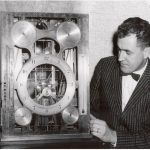
machine, the first tide predicting machine used in the United States
(1885-1914). Photograph taken in early 1960s.
About the author: Steacy Dopp Hicks (April 19, 1925 — ), Physical Oceanographer. The Michigan Alumnus, Volume 28 includes the announcement of the marriage of Myona Lillian Dopp, ’20, to Milford Steacy Hicks, December 22, 1921, at Detroit, Mich. A mylife.com search reveals the following:
Steacy Hicks is 93 years old and was born on 04/19/1925… Previous to Steacy’s current city of Sterling, VA, Steacy Hicks lived in Arlington VA and Falls Church VA. Sometimes Steacy goes by various nickname including Steacy D Hicks. Background details that you might want to know about Steacy include: ethnicity is Caucasian, whose political affiliation is currently a registered Democrat; and religious views are listed as Christian. Currently, Steacy is married. Steacy’s personal network of family, friends, associates & neighbors include Marilyn Hicks, Elizabeth Hicks, Stephen Hicks, Tammy Hicks and April Hicks.
From the description of the document:
Steacy D. Hicks was assigned to the destroyer USS Conway throughout his Navy service (October 1944–May 1946). During World War II, Hicks served as a signalman 3rd class and, after the war, was promoted to 2nd class status (January 1946). Hicks initially worked as a sightsetter, but was later assigned to the signal bridge.
In an “About the Author” piece for Understanding Tides (U.S. Department of Commerce, National Oceanic and Atmospheric Administration National Ocean Service, 2006), Michael Szabados Director, Center for Operational Oceanographic Products and Services, wrote,
Mr. Hicks retired in December 1990 after 30 years of distinguished Federal Service, 28 years of which was providing the Nation with expertise in tides and currents. A graduate of UCLA in 1950 with a major in meteorology, Mr. Hicks received his Masters Degree in physical oceanography from the Scripps Institution of Oceanography of the University of California in 1952. From 1952 to 1962, Mr. Hicks was an Instructor and Assistant Professor of Physical Oceanography at the University of Rhode Island. Since entering the Federal Government (old Coast and Geodetic Survey) in 1962, he has served in research positions; as Chief, Physical Oceanography Division; and Chief, Physical Oceanographic Research Group; until assuming duties as Senior Physical Oceanographer, all in the National Oceanic and Atmospheric Administration (NOAA) and its predecessor organizations. He also has been an Associate Professorial Lecturer in Physical Oceanography at The George Washington University. Mr. Hicks was selected a Fellow in the first class (1964-65) of the Department of Commerce Science and Technology Fellowship Program. In the Program, he studied at the Geophysical Fluid Dynamics Laboratory of NOAA. Mr. Hicks is a 1970 graduate of the senior resident course (College of Naval Warfare) of the U.S. Naval War College in Newport, RI. He received the Silver Medal of the U.S. Department of Commerce for his research on tides, long-period sea-level variations, and tidal datums; and has authored numerous papers in refereed scientific journals on these subjects. His nine military awards from WWII, while serving in the Destroyer USS Conway (DD507), include the Combat-Action Ribbon and the Asiatic-Pacific Campaign Medal with six major engagement stars.
About the diary: Typescript identified as Diary of a cruise in USS Conway (DD-507) in the Digital Collections of East Carolina University. From the document’s description:
The typescript diary, with additional observations, details activities aboard USS Conway (13 October 1944–2 May 1946). Throughout the diary, lists of American and British ships in the vicinity of the Conway are listed. Specific shore bombardments, aerial operations, and battles in and around the Philippines Islands are described including Leyte, Lingayen, Luzon, Corregidor, Parang, and Mindanao (25 November 1944–7 June 1945; pp. 3–14); Japanese kamikaze attacks on American ships (26 November, 13 and 15 December 1944; 8–9 January 1945; pp. 3, 5, 7); military actions in Borneo (15 June–2 July 1945; pp. 14–16); and damage suffered by light cruisers USS Birmingham (CL-42) and USS St. Louis (CL-49) are detailed (10 and 27 November 1944; pp. 2–3). Other topics mentioned include a description of a radio broadcast by Tokyo Rose and propaganda pertaining to American casualties (7 January 1945; p. 7); use of peacetime honor rendering procedures by British ships in Hong Kong (10 October 1945; p. 20); and etiquette to be followed while on liberty in Hong Kong (12 October 1945; pp. 21). At the end of the typescript, Hicks includes a narrative concerning his feelings toward Conway and life in the Navy during World War II.
The Philippine Diary Project includes only those portions of the diary related to the author’s travel to, in, or from, the Philippines.